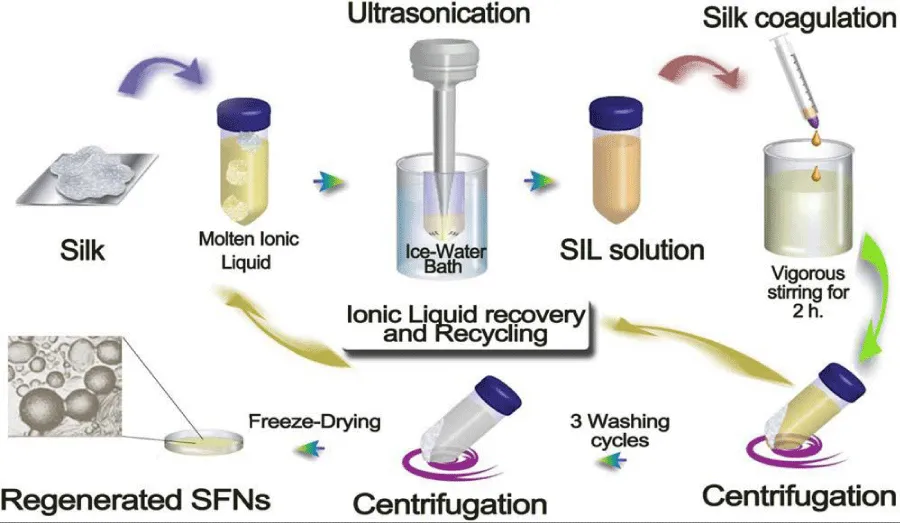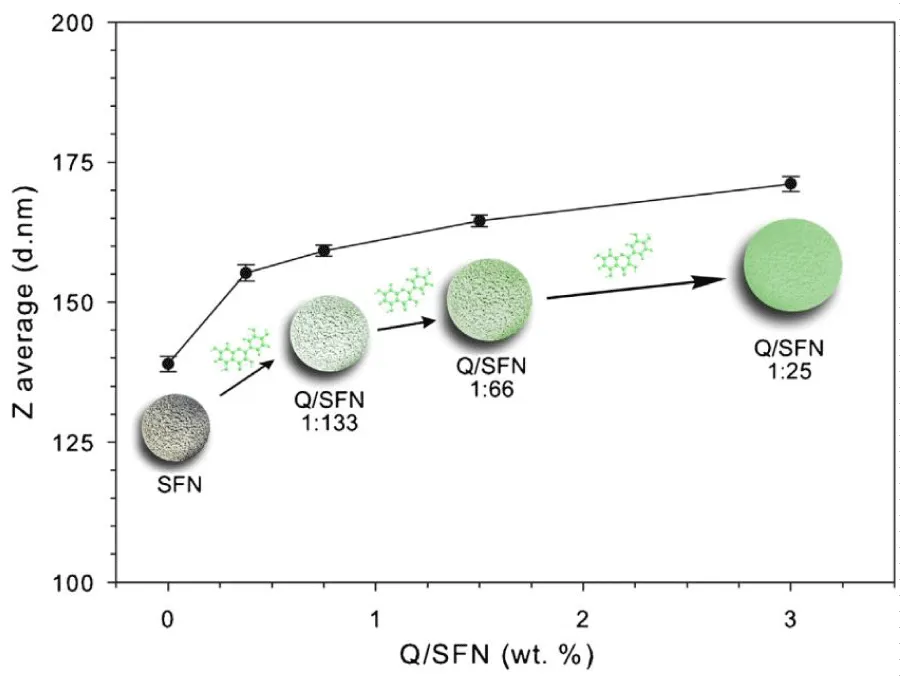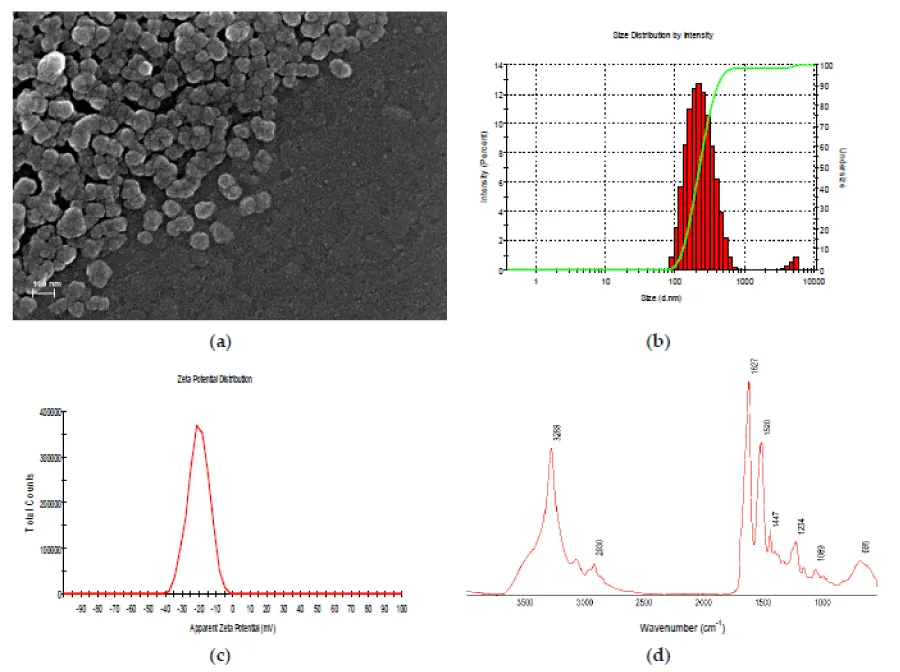International Journal of Nanomaterials, Nanotechnology and Nanomedicine
Silk Fibroin Nanoparticles (SFNs) for nanoencapsulation of bioactive molecules
Kheiria Hcini*
Faculty of Sciences of Gafsa, University Campus Sidi Ahmed Zarroug, University of Gafsa, Gafsa 2112, Tunisia, E-mail: [email protected]
Cite this as
Hcini K (2024) Silk Fibroin Nanoparticles (SFNs) for nanoencapsulation of bioactive molecules. Int J Nanomater Nanotechnol Nanomed 10(1): 012-015. DOI: 10.17352/2455-3492.000057Copyright License
© 2024 Hcini K. This is an open-access article distributed under the terms of the Creative Commons Attribution License, which permits unrestricted use, distribution, and reproduction in any medium, provided the original author and source are credited.Silk Fibroin Nanoparticles (SFNs) have become a reliable and effective biomaterial for nanoencapsulation in several fields such as food, biocosmetics, and medical products due to their physicochemical characteristics. Recently, it has also been developed for application in biomaterials and regenerative medicine, also for cellular nanoencapsulation, and drug delivery systems. Silk fibroin is a natural biomaterial relatively not expensive, biocompatible, eco-friendly, and non-toxic FDA-approved protein derived from the Bombyx mori silkworm cocoon. Fibroin has recently been investigated in the drug field carrier for controlled release. Their application has also become widespread in regenerating therapy as a support for regenerating tissues, as well as in nanomedicine. Furthermore, SFNs have been studied as a carrier for single bioactive molecules such as resveratrol, quercetin, or curcumin for volatile compounds, and for vegetal oils in the form of emulsions. The nanoencapsulation of bioactive compounds in a biopolymer of silk fibroin can be efficiently protected from harmful environmental agents like light, oxygen, or water. The present review reveals that silk fibroin nanoparticles constitute a useful biomaterial to protect, stabilize, and deliver bioactive components. This is a promising combination in safety food, biocosmetic products, nanomedicine, and healthcare.
Introduction
Silk Fibroin (SF) extracted from Bombyx mori cocoons has a unique association of physicochemical and biological properties, including nontoxicity, biocompatibility, and biodegradability, making it an outstanding biomaterial for use in a wide range of therapies [1]. This biopolymer, formulated as particles, has important applications in different domains for its ability to protect and deliver a wide range of natural bioactive compounds [2-6]. Silk Fibroin Nanoparticles (SFNs) constitute a highly customizable biomaterial with effective potential in biomedical applications. This biopolymer is used in medicine for its capacity to act as a reversible carrier of bioactive molecules [7-9]. In order to stabilize and protect delicate and precious bioactive compounds, it is beneficial to encapsulate them prior to application. The application of nanoencapsulation is becoming increasingly important in the pharmaceutical, food, cosmetics, textile, personal care, chemical, biotechnology, and medicinal industries due to its potential for stabilization and controlled release under desired conditions of bioactive compounds [5,6,10-12]. Bioactive compounds encapsulated in a silk fibroin biopolymer can be efficiently protected from harmful environmental agents like light, oxygen, or water. Their extensive hydrogen bonding, their hydrophobic nature, and their high degree of crystallinity contribute to the stability of silk biomaterials [13-15]. This mini-review provides an overview of silk fibroin nanoparticles as a biopolymer for nanoencapsulation of biologically active compounds.
Silk Fibroin Nanoparticles (SFNs) as a biomaterial for nanoencapsulation
Various materials have been previously investigated for nanoencapsulation. Proteins are particularly effective encapsulating biopolymers because their physicochemical and biological characteristics (including amphiphilic character, capacity to self-associate and interact with a variety of substances, high molecular weight, and molecular chain flexibility) provide excellent functional properties for encapsulation. Though many biomaterials have been studied for encapsulation in food products, biocosmetic, and medicinal applications, Silk Fibroin (SF) is an especially attractive biopolymer due to its unique chemical and physical properties [2].
Bombyx mori SF is composed of two chains – a heavy chain, approximately 325 kDa, and a light chain, approximately 25 kDa – linked by a single disulfide bridge. The heavy chain of SF is composed of crystalline and amorphous domains. The crystalline domain consists of glycine–alanine repeats interconnected with serine and tyrosine amino acids. The amorphous domain consists of the more bulky amino acids such as aspartic acid. The crystalline domains, which form antiparallel β-sheet secondary structures, are interspersed, by the more flexible amorphous regions. The two chains are bound together by a sericin coating and the removal of this sericin coating, before fibroin processing, removes the thrombogenic and inflammatory responses of SF. This unique structure allows silk to self-assemble into crystallized β-sheets. Their high degree of crystallinity, extensive hydrogen bonding, and their hydrophobic nature contribute to the stability of silk biomaterials [3, 16].
Silk fibroin is a biopolymer extracted from the domesticated silkworm (Bombyx mori) cocoons (Figure 1) that is FDA-approved, edible, non-toxic, biocompatible, biodegradable and relatively not expensive [15,17]. Recently silk fibroin has been investigated as a scaffold for tissue engineering and a drug carrier for controlled release. Owing to its excellent biocompatibility and physicochemical properties, SF constitutes an attractive biomaterial in biomedical and tissue engineering applications [3,6,9,16,18]. Similarly, there are several studies reporting the suitability of SFNs as active vehicles for the transport and release of biomolecules targeting cancer cells or to treat inflammatory conditions such as inflammatory bowel disease and periodontitis [5,19-21]. Furthermore, SFNs have been investigated as an effective encapsulant for single antioxidant molecules such as resveratrol, quercetin, or curcumin for volatile compounds, and for vegetal oils in the form of emulsions [5,6,15]. On account of all of these properties, silk fibroin has become a promising tool for nanoencapsulation of bioactive molecules.
Nanoencapsulation is a process of encapsulating a material containing an active ingredient by a protective coating layer, or embedded within an encapsulating matrix or membrane, providing a physical barrier between the incorporated compound and the surrounding environment. This technique protects sensitive and precious molecules from deterioration by shielding them from harmful environmental conditions. The barrier that the encapsulating material provides can also delay the evaporation of volatile compounds particularly if the compound interacts with the encapsulant material. In addition to stabilizing and protecting encapsulated flavors, fragrances, oils, and phenolic compounds, nanoencapsulation may also be able to provide controlled release under specific conditions [3,6,22]. Quercetin loaded into the Silk Fibroin Nanoparticles (QSFNs) conserved the antioxidant activity in comparison with the equivalent amount of free Quercetin. QSFNs provide the capacity to protect the drug from degradation in the adverse gastrointestinal tract environment, enabling its easy transport and internalization through the intestinal epithelial cells or colon, and thus improving its pharmacokinetics and bioavailability after oral administration and making them an excellent platform for the future development of nanotherapies (Figure 2) [5,23,24].
The loaded nanoparticles with rosemary polyphenolic compounds were characterized in terms of morphology, size, polydispersity, Z-potential, secondary structure of the protein, encapsulation efficiency, loading content, and antioxidant activity (Figure 3). The encapsulated polyphenols retained nearly 85% of the radical scavenging activity against DPPH after 24 h. of incubation at 37 °C. The results showed that silk fibroin nanoparticles loaded with rosemary post-distilled extracts are thus a promising combination for several applications in food technology or nanomedicine. In reference to the loading polyphenol content determinations, diterpene fraction along with the phenolic acids, salvianic and rosmarinic acids were retained as major components in the SFNs, although a deeper study should be developed [12].
Furthermore, polyphenolic compounds such as curcumin, quercetin, and resveratrol are known to exhibit anti-inflammatory effects in several cell types [25-28]. Previous works proved the utility of SFNs as drug carriers due to their optimal physicochemical properties and biosafety. For instance, several studies have described that SFN enhances polyphenol bioavailability with a low cytotoxic effect, highlighting their potential use as therapeutics in different diseases such as cancer or inflammatory diseases [5,9,15,20,29,30].
Nanoencapsulation has a number of interesting advantages in different domains due to its potential for stabilization and delivery of delicate and precious bioactive molecules. Thus, bioactive compounds encapsulated in a biopolymer can be efficiently protected from harmful environmental agents like light, oxygen, or water [9,12]. In Nanomedicine, advances in targeted drug delivery systems using nanoparticles improve the precision and effectiveness of cancer treatments and the development of nanoscale imaging agents for earlier and more accurate disease diagnosis [31].
Conclusion
Silk Fibroin Nanoparticles (SFNs) represent an effective biopolymer for nanoencapsulation of bioactive molecules in safety-food, biocosmetic, and soft medecine due to their physicochemical characteristics. Biologically active molecules encapsulated in this biomaterial can be efficiently protected from chemical and physical damage. Recently, SFNs have also been developed for application in biomaterials and regenerative medicine, also for cellular nanoencapsulation, and controlled drug delivery systems. Thus, nanoencapsulation is one of the techniques used to raise the protection of bioactive compounds and to be improved under controlled release. This technique may be defined as a method by which one or more bioactive natural products are released under specific conditions. This controlled release could be used to maximize the effectiveness and reliability of delicate and valuable bioactive compounds.
The author thanks the “Ministry of Higher Education, Scientific Research and Technology, Tunisia”, for supporting this study. She also extends their appreciation to the Instituto Murciano de Investigación y Desarrollo Agrario y Medioambiental (IMIDA), La Alberca, 30150 Murcia, Spain.
Data availability statement
The data presented in this study are available from the corresponding author upon reasonable request.
- Omenetto FG, Kaplan DL. New opportunities for an ancient material. Science. 2010 Jul 30;329(5991):528-31. doi: 10.1126/science.1188936. PMID: 20671180; PMCID: PMC3136811.
- Pritchard EM, Normand V, Hu X, Budijono S, Benczédi D. Encapsulation of oil in silk fibroin biomaterials. J Appl Polym Sci. 2014; 131:1-11.
- Lozano-Pérez AA, Montalbán MG, Aznar-Cervantes SD, Cragnolini F, Cenis JL, Víllora G. Production of silk fibroin nanoparticles using ionic liquids and high-power ultrasounds. J Appl Polym. Sci. 2015; 132: 41702.
- Elia R, Guo J, Budijono S, Normand V, Benczédi D, Omenetto F, Kaplan DL. Encapsulation of Volatile Compounds in Silk Microparticles. J Coat Technol Res. 2015 Jul;12(4):793-799. doi: 10.1007/s11998-015-9668-1. Epub 2015 May 2. PMID: 26568787; PMCID: PMC4640459.
- Lozano-Pérez AA, Rivero HC, Pérez Hernández MDC, Pagán A, Montalbán MG, Víllora G, Cénis JL. Silk fibroin nanoparticles: Efficient vehicles for the natural antioxidant quercetin. Int J Pharm. 2017 Feb 25;518(1-2):11-19. doi: 10.1016/j.ijpharm.2016.12.046. Epub 2016 Dec 21. PMID: 28012995.
- Montalbán MG, Coburn JM, Lozano-Pérez AA, Cenis JL, Víllora G, Kaplan DL. Production of Curcumin-Loaded Silk Fibroin Nanoparticles for Cancer Therapy. Nanomaterials (Basel). 2018 Feb 24;8(2):126. doi: 10.3390/nano8020126. PMID: 29495296; PMCID: PMC5853757.
- Hofmann S, Foo CT, Rossetti F, Textor M, Vunjak-Novakovic G, Kaplan DL, Merkle HP, Meinel L. Silk fibroin as an organic polymer for controlled drug delivery. J Control Release. 2006 Mar 10;111(1-2):219-27. doi: 10.1016/j.jconrel.2005.12.009. Epub 2006 Feb 3. PMID: 16458987.
- Zhao Z, Li Y, Xie MB. Silk fibroin-based nanoparticles for drug delivery. Int J Mol Sci. 2015 Mar 4;16(3):4880-903. doi: 10.3390/ijms16034880. PMID: 25749470; PMCID: PMC4394455.
- Ruiz-Alcaraz AJ, Núñez-Sánchez MÁ, Asensio Ruiz MA, Martínez-Sánchez MA, Oliva-Bolarín A, Martínez Martínez T, Pérez Cuadrado JJ, Ramos-Molina B, Lozano-Pérez AA. Optimizing the Preparation of Silk Fibroin Nanoparticles and Their Loading with Polyphenols: Towards a More Efficient Anti-Inflammatory Effect on Macrophages. Pharmaceutics. 2023 Jan 12;15(1):263. doi: 10.3390/pharmaceutics15010263. PMID: 36678894; PMCID: PMC9861267.
- Bayçin D, Altiok E, Ulkü S, Bayraktar O. Adsorption of olive leaf (Olea europaea L.) antioxidants on silk fibroin. J Agric Food Chem. 2007 Feb 21;55(4):1227-36. doi: 10.1021/jf062829o. Epub 2007 Jan 30. PMID: 17261014.
- Pritchard EM, Dennis PB, Omenetto F, Naik RR, Kaplan DL. Review physical and chemical aspects of stabilization of compounds in silk. Biopolymers. 2012 Jun;97(6):479-98. doi: 10.1002/bip.22026. Epub 2012 Jan 23. PMID: 22270942; PMCID: PMC4527307.
- Hcini K, Lozano-Pérez AA, Luis Cenis J, Quílez M, José Jordán M. Extraction and Encapsulation of Phenolic Compounds of Tunisian Rosemary (Rosmarinus officinalis L.) Extracts in Silk Fibroin Nanoparticles. Plants (Basel). 2021 Oct 27;10(11):2312. doi: 10.3390/plants10112312. PMID: 34834676; PMCID: PMC8618009.
- Altman GH, Diaz F, Jakuba C, Calabro T, Horan RL, Chen J, Lu H, Richmond J, Kaplan DL. Silk-based biomaterials. Biomaterials. 2003 Feb;24(3):401-16. doi: 10.1016/s0142-9612(02)00353-8. PMID: 12423595.
- Desai KGH, Park HJ. Recent developments in microencapsulation of food ingredients. Drying Technol. 2005; 23:1361-1394.
- Lozano-Pérez AA, Rodriguez-Nogales A, Ortiz-Cullera V, Algieri F, Garrido-Mesa J, Zorrilla P, Rodriguez-Cabezas ME, Garrido-Mesa N, Utrilla MP, De Matteis L, de la Fuente JM, Cenis JL, Gálvez J. Silk fibroin nanoparticles constitute a vector for controlled release of resveratrol in an experimental model of inflammatory bowel disease in rats. Int J Nanomedicine. 2014 Sep 23;9:4507-20. doi: 10.2147/IJN.S68526. PMID: 25285004; PMCID: PMC4181735.
- Mottaghitalab F, Farokhi M, Shokrgozar MA, Atyabi F, Hosseinkhani H. Silk fibroin nanoparticle as a novel drug delivery system. J Control Release. 2015 May 28;206:161-76. doi: 10.1016/j.jconrel.2015.03.020. Epub 2015 Mar 20. PMID: 25797561.
- Ajisawa A. Dissolution of silk fibroin with calcium chloride/ethanol aqueous solution. J Seric Sci Jpn. 1998; 67(2):91-94.
- Liu Q, Liu H, Fan Y. Preparation of silk fibroin carriers for controlled release. Microsc Res Tech. 2017 Mar;80(3):312-320. doi: 10.1002/jemt.22606. Epub 2015 Dec 6. PMID: 26638113.
- Rodriguez-Nogales A, Lozano-Pérez AA, Aznar-Cervantes SD, Algieri F, Garrido-Mesa J, Garrido-Mesa N, Vezza T, Utrilla MP, Cenis JL, Rodríguez-Cabezas ME, Gálvez J. Effect of aqueous and particulate silk fibroin in a rat model of experimental colitis. Int J Pharm. 2016 Sep 10;511(1):1-9. doi: 10.1016/j.ijpharm.2016.06.120. Epub 2016 Jun 27. PMID: 27363935.
- Giménez-Siurana A, Gómez García F, Pagan Bernabeu A, Lozano-Pérez AA, Aznar-Cervantes SD, Cenis JL, López-Jornet P. Chemoprevention of Experimental Periodontitis in Diabetic Rats with Silk Fibroin Nanoparticles Loaded with Resveratrol. Antioxidants (Basel). 2020 Jan 19;9(1):85. doi: 10.3390/antiox9010085. PMID: 31963913; PMCID: PMC7022414.
- Ma Y, Duan L, Sun J, Gou S, Chen F, Liang Y, Dai F, Xiao B. Oral nanotherapeutics based on Antheraea pernyi silk fibroin for synergistic treatment of ulcerative colitis. Biomaterials. 2022 Mar;282:121410. doi: 10.1016/j.biomaterials.2022.121410. Epub 2022 Feb 16. PMID: 35202934.
- Kumari A, Yadav SK, Pakade YB, Singh B, Yadav SC. Development of biodegradable nanoparticles for delivery of quercetin. Colloids Surf B Biointerfaces. 2010 Oct 15;80(2):184-92. doi: 10.1016/j.colsurfb.2010.06.002. Epub 2010 Jun 11. PMID: 20598513.
- Wu TH, Yen FL, Lin LT, Tsai TR, Lin CC, Cham TM. Preparation, physicochemical characterization, and antioxidant effects of quercetin nanoparticles. Int J Pharm. 2008 Jan 4;346(1-2):160-8. doi: 10.1016/j.ijpharm.2007.06.036. Epub 2007 Jun 28. PMID: 17689897.
- Zhao J, Liu J, Wei T, Ma X, Cheng Q, Huo S, Zhang C, Zhang Y, Duan X, Liang XJ. Quercetin-loaded nanomicelles to circumvent human castration-resistant prostate cancer in vitro and in vivo. Nanoscale. 2016 Mar 7;8(9):5126-38. doi: 10.1039/c5nr08966b. PMID: 26875690.
- Radkar V, Hardej D, Lau-Cam C, Billack B. Evaluation of resveratrol and piceatannol cytotoxicity in macrophages, T cells, and skin cells. Arh Hig Rada Toksikol. 2007 Sep;58(3):293-304. doi: 10.2478/v10004-007-0020-8. PMID: 17913683.
- Li Y, Yao J, Han C, Yang J, Chaudhry MT, Wang S, Liu H, Yin Y. Quercetin, Inflammation and Immunity. Nutrients. 2016 Mar 15;8(3):167. doi: 10.3390/nu8030167. PMID: 26999194; PMCID: PMC4808895.
- Peng Y, Ao M, Dong B, Jiang Y, Yu L, Chen Z, Hu C, Xu R. Anti-Inflammatory Effects of Curcumin in the Inflammatory Diseases: Status, Limitations and Countermeasures. Drug Des Devel Ther. 2021 Nov 2;15:4503-4525. doi: 10.2147/DDDT.S327378. PMID: 34754179; PMCID: PMC8572027.
- Ruiz-Alcaraz AJ, Martínez-Sánchez MA, García-Peñarrubia P, Martinez-Esparza M, Ramos-Molina B, Moreno DA. Analysis of the anti-inflammatory potential of Brassica bioactive compounds in a human macrophage-like cell model derived from HL-60 cells. Biomed Pharmacother. 2022 May;149:112804. doi: 10.1016/j.biopha.2022.112804. Epub 2022 Mar 10. Erratum in: Biomed Pharmacother. 2022 Aug;152:113271. PMID: 35279599.
- Gou S, Huang Y, Wan Y, Ma Y, Zhou X, Tong X, Huang J, Kang Y, Pan G, Dai F, Xiao B. Multi-bioresponsive silk fibroin-based nanoparticles with on-demand cytoplasmic drug release capacity for CD44-targeted alleviation of ulcerative colitis. Biomaterials. 2019 Aug;212:39-54. doi: 10.1016/j.biomaterials.2019.05.012. Epub 2019 May 9. PMID: 31103945.
- Xie D, Zhou X, Xiao B, Duan L, Zhu Z. Mucus-Penetrating Silk Fibroin-Based Nanotherapeutics for Efficient Treatment of Ulcerative Colitis. Biomolecules. 2022 Sep 8;12(9):1263. doi: 10.3390/biom12091263. PMID: 36139101; PMCID: PMC9496219.
- Sahu MK, Yadav R, Tiwari SP. Recent advances in nanotechnology. Int J Nanomater Nanotechnol Nanomed. 2023; 9(2):015-023.

Article Alerts
Subscribe to our articles alerts and stay tuned.
 This work is licensed under a Creative Commons Attribution 4.0 International License.
This work is licensed under a Creative Commons Attribution 4.0 International License.




 Save to Mendeley
Save to Mendeley
